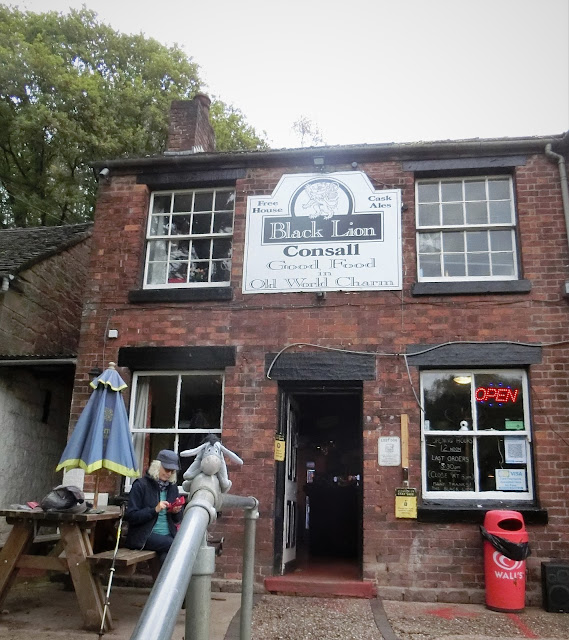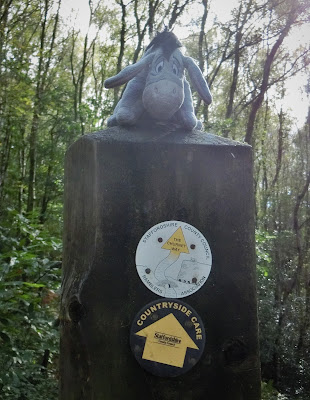Wet for most of the last week &, with no reason to venture out in such weather, this was our first excursion for a while! Totally different from LeJog in 2011 when I felt obliged to walk every day &, indeed, we had a deadline day to finish!
With Kirstie keen to walk the next leg northwards with us it was time to turn our attention to a southern route - no easy task! First thoughts had been to head across to The Trent & Mersey Canal at Barlaston & follow that towards Stafford which would have taken us along a lot of minor roads & previously-walked paths... as well as skirting Stoke, where increased restrictions were being discussed.
Finally opted for The Staffordshire & Churnet Ways, today taking us to Alton via Consall & Froghall... albeit in a south-easterly direction!
Chapel House, Belmont, Ipstones
A longer walk on the cards today so, no messing about! Straight across the fields from home heading for the Caldon Canal & both the footpaths we were to follow!
Chapel House is something of an anomaly in that it was built by John Sneyd of Belmont Hall whilst he was, allegedly, at odds with the vicar of St Leonard's in Ipstones, William Carlisle. Yet at the same time he & his family were paying for the rebuilding of St Leonard's!
Whatever the argument, Sneyd & the vicar made it up & this 'alternative' church was never used other than as a house... although a 'local' tells me there was once a nunnery here...
... & why the South African name? Sneyd's next-door neighbour at Belmont Farm was the same William Carlisle & his son was, in 1820, to emigrate to South Africa.
To complicate matters still further, when Carlisle died in 1833 Sneyd became the 'new' vicar at St Leonard's - a post he held for a further 28 years.
All very curious!
The Devil's Staircase wends its way down to Consall Forge in the Churnet Valley from beside Belmont Hall. These crumbling concrete steps replaced their well-worn stone predecessors which, presumably, took workers down to the forge, the mills & the lime-kilns that once littered the banks of the Caldon Canal. Devil's Staircase indeed...!
There haven't been many pub stops on this expedition... unlike last time around when I visited 200 different establishments!
This one is close to home & one of my favourites. They opened just as we were passing their door so we couldn't really not stop! Just as well we did as it rained quite heavily & we were able to shelter in their marquee!
'nuff said! We didn't find him!
Consall Station
Almost opposite the Black Lion pub &, interestingly, only opened in 1902 when much of the area's industrial activity had sharply declined & the railway was looking to develop tourism! The line itself had opened in 1849.
I love the way that the platform hangs over the canal to squeeze the railway between canal & river!
Canal, river & railway just a hundred metres or so south of the station!
For almost a mile before the Black Lion river & canal run together as the valley is too narrow to accommodate both!
Changeover Bridge, Caldon Canal
So, back to James Brindley (see Day 5!). As a branch of The Trent & Mersey this route was surveyed by Brindley but wasn't completed until six years after his death.
The Changeover Bridge was built by North Staffordshire Railway in the late 1840s, switching the towpath to the opposite bank to give them room to construct their Churnet Valley line.
The bridge was built from old rails!
Cherry Eye Bridge
Although the canal was built, primarily, to carry limestone quarried at Caldon Low (see Day 1!) & transported to Froghall via inclined tramways it also supported countless mines, kilns & other industries clustered along the valley.
Cherry Eye ironstone mine was the last of them to close & was situated just above this bridge - it took its name from the redness of the ore to be seen around the eyes of the miners, just like the blackness around coal-miners' eyes.
Site of Thomas Bolton Copperworks, Froghall
All that remains of the once-proud, world-famous copper-producing company. They manufactured the first trans-Atlantic telegraph cables just along the railway at Oakamoor, opened this site in 1892 & provided the cabling for the Beijing Olympic Games as recently as 2008.
The site now houses Agility Defense & Government Services (not a spelling error!) which seems to involve a lot of military stuff!
Abandoned The Staffordshire Way just before Bolton's but continued along The Churnet Way, a 30-mile footpath from the river's source below The Roaches to the River Dove south of Rocester.
According to an Environment Agency report in 2006 the Churnet was once, probably, the most polluted river in Europe - hardly surprising given the history we'd just walked through!
A very different river these days... though heavy rain still leads to frequent flooding!
The Staffordshire Way rejoined us close to this point having taken an unreasonably steep diversion through the village of Kingsley Holt!
Just beyond the second field here is an embankment on the left which, over 200 years ago, was the base for the tramway that carried coal from the Cheadle collieries to a canal wharf... long before the railway was even thought of!
East Wall Farm, Hawksmoor
Impressive farm buildings dating from the 1850s & unchanged since then... so, comparatively modern for around here!
Before that the site was occupied by miners' & canal workers' cottages that disappeared soon after the closure of the East Wall colliery &, in 1846, the closure of the canal.
Even before that this was the site of a medieval iron forge... now it's all National Trust territory!
Ousal Dale
These fine black swans now occupy the area that once belonged to Alton smelting mill. Built in 1741 to smelt lead ore brought in from Ecton in the Manifold Valley (see Day 2!), the site comprised "a certain smelting mill, refinery, slag hearth, smith's shop, two houses, a barn & about nine acres of land lying near the same with a pool of water."
Some 45 years later the smelting mill had become a corn-grinding mill where a 20 foot water-wheel drove three pairs of stones!
Back to The Churnet Way for the last stretch of today's walk to Alton... but felt guilty I didn't have a Staffordshire Way sign photo so here's Eeyore outside the Rambler's Retreat, a popular 'Country Tearoom'!
Canal, railway, cycle-track or footpath? OK - all of them!
The Froghall - Uttoxeter canal was started in 1807 but not completed until 1811: it carried little traffic & consistently lost money. Useful for the Boltons in Oakamoor, the collieries in Cheadle & for shipping limestone south from Caldon Low to the kilns at Alton, Rocester & Uttoxeter... but none of that would make it profitable.
When the North Staffordshire Railway took over The Trent & Mersey Company its days were numbered... but not before transporting all the necessary railway construction equipment!
The railway lasted rather longer, being closed in stages between 1964 & 1988.

Alton Station
Quite a grand building for an industrial railway station & now available to rent as a holiday cottage!
Obviously, more to this than meets the eye & that's down to the Earl of Shrewsbury & the nearby Alton Castle & Alton Towers! The station was built to impress guests & visitors to the 19th Earl's family home... along with a luggage lift to transport baggage directly up to the Towers!
In 1954 the station was renamed Alton Towers but reverted to its former name 25 years later... just before Alton Towers opened as a Theme Park!
There is still talk of reopening the railway to bring visitors to the valley & to the Park...
Alton Castle
This is the mid-19th century Gothic-revival castle built by the 16th Earl's famous architect, Augustus Pugin.
More about this when we get a little closer at the start of our next walk!
The Talbot, Alton
There's been a shortage of pub stops on this expedition so far so I don't feel guilty about two in one day... particularly given the weather!
This is one of the oldest buildings in the village, appearing on a map of Alton in 1775. Talbot was the family name of the Earls of Shrewsbury so this could well have been named after the 14th Earl, George!
A more famous 'Talbot' was probably Charles Henry John, the 20th Earl, who founded Talbot Cars in 1902!
Finished our day by walking up through the village & past this impressive old lock-up. Built in 1819, I'm sure it's held many a drunk over the years...!
Today's distance : 11.20 miles 18.02 kilometres
Cumulative : 55.23 miles 88.90 kilometres
Direction of Travel : South-East!
Progress : We are now 394.89 miles from John o' Groats (+5.34miles)!
& 260.02 miles from Land's End (-1.67miles)!





















No comments:
Post a Comment